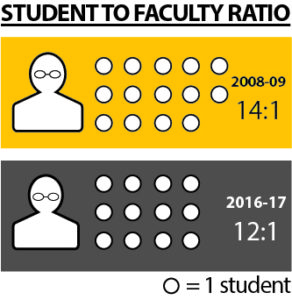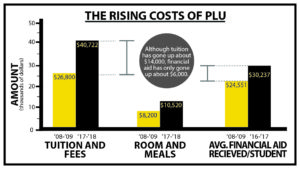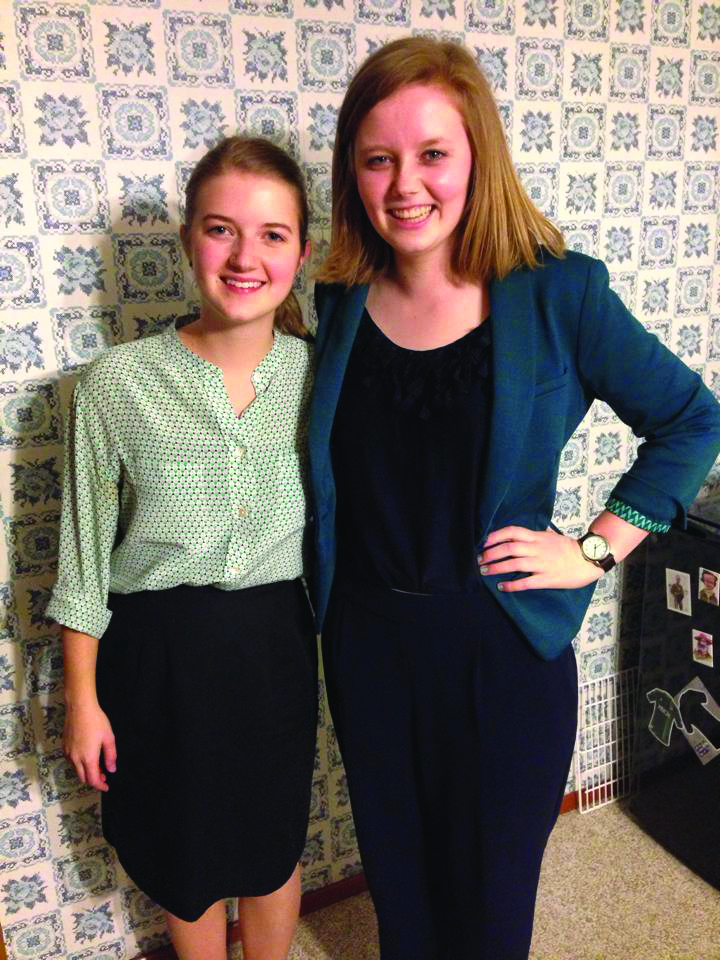MAST STAFF; mast@plu.edu
‘Money talks,’ as the old saying goes — and the conversation Pacific Lutheran University students are missing out on is the $3 million budget shortfall.
Earlier this year, administrators informed faculty that PLU is experiencing a budget gap of about $3 million.
But the university largely failed to mention the financial problem (or crisis, as some have called it) to students.
The Mast obtained several emails that were sent to faculty members about the situation. Changes that will impact the entire PLU community were mentioned in those emails, such as eliminating raises for faculty and staff next year and no longer automatically replacing tenured faculty lines when faculty members retire or leave PLU.
In a Feb. 9 email, Provost and Senior Vice President for Academic Affairs Rae Linda Brown explained that PLU hired the Austen Group, a consulting firm that provides institutional research to higher education institutions, to “provide options to help us achieve maximum benefits in our academic programs while preserving savings.” A report from the firm is expected to be released to PLU administrators in April.
The Mast reached out to multiple professors for comment on how the budget shortfall is impacting them and, although multiple faculty members expressed that it was a stressful situation, they declined to comment publicly on the issue. If any faculty members are willing to comment, we invite them to contact The Mast.
CAUSES
The PLU budget functions much like a personal budget. The university expects a certain amount of revenue to come in and projects expenses for each academic year.
PLU’s revenue includes student tuition, on-campus housing, meal plans and the Garfield Station apartments. Expenses include faculty and staff pay and facility costs.

Allan Belton, the Vice President for Finance and Administration at PLU, explained that like many small private schools, PLU relies heavily on student enrollment. About 75 percent of PLU’s revenue comes from net student tuition.
The 2016-2017 academic year was expected to bring about 4 percent more returning students than the 2,692 undergrad , full-time students actually enrolled. In monetary terms, that’s about $3 million less revenue than expected.
A similar budget shortfall occurred at PLU during the early ‘90s, according to Belton.
Documents obtained from the PLU archives explained that during the Summer of 1993 former President Anderson sent the PLU community a memo about a budget shortfall of $1.3 million.
As the university reeled from this shortfall, they worked on cutting part-time faculty members, reducing paid time for faculty research, and considering the closure of East Campus. These same documents discussed cutting J-term (or Interim, as it was called then) and the possibility of certain academic programs going under.
A document published in 1995 discussing the proper procedures for terminating tenured faculty members is available to view at mastmedia.plu.edu
There are many parallels between the budget shortfall PLU experienced in the early ‘90s and the current financial situation PLU is experiencing, including a lack of clear communication from the administration.
WHY HAVEN’T PLU STUDENTS HEARD ABOUT THIS?
“I don’t know anything about the budget,” Showalter said. “All I know is that I pay tuition and I have scholarships that help me out a lot.”
While faculty have known about the shortfall and declining student enrollment since the beginning of this year, many students aren’t aware of the budget gap.
First-year Megan Packer said she wants to know how the budget gap will impact her. “I didn’t even know there was a problem until now.”
As a private institution, PLU doesn’t have the same obligation to be transparent about its budget as public schools, but the PLU annual finance report is available to review online at https://www.plu.edu/finance-admin/budget-finance.
ASPLU and Belton combined efforts last year to better inform PLU students about where their money is going. The series included sessions and information on where tuition dollars go and how PLU earns its revenue.
But many students, like junior Malena Showalter, still don’t know where their money is going.
“I don’t know anything about the budget,” Showalter said. “All I know is that I pay tuition and I have scholarships that help me out a lot.”
Belton said he hopes students continue to question where their money is going.
“Students need to be asking those questions and ask very pointedly, ‘If I’m paying, what do you do with that money?’” he said.
Belton said he welcomes students to email him at allan.belton@plu.edu or meet with him if they have questions about the budget.
“I think that transparency is the number one thing the budget needs,” said senior Monica Richardson, the Associated Students of PLU Public Relations Director. “Students should know where their money is going.”
SOLUTIONS
Belton explained that a contingency fund he advocated for last year was able to cover most of the shortfall so PLU could have time to figure out solutions to the problem.
“If we hadn’t done that, we would be dealing with issues this year,” Belton said. “Instead, we have time to be thoughtful about it.”
Groups made up of PLU faculty and administration have been discussing possible solutions to deal with the budget shortfall since the beginning of this year.
PLU’s Vice President for Student Life Joanna Royce-Davis said, “The goal across the university has been [to] have the most positive impact by clear prioritization of resources and good stewardship of resources and the least potential for negative impact on student experience.”
Belton said faculty have been useful in setting priorities.
“I could not be more impressed with the faculty here,” he said, “and their ability to identify the situation and deal with the situation.”
Royce-Davis said she doesn’t “expect there to be negative impact on student experience,” and that the teams are striving to be “conscious,” “aware” and “diligent about attending to that.”
“Students need to be asking those questions and ask very pointedly, ‘If I’m paying, what do you do with that money?’” Allen Belton, Vice President of Finance and Administration.
RETENTION
Retention is an important area where the budget crisis has forced PLU to rethink its current policies. Student retention is defined as the number of first-year students who return for their second year.
This year PLU welcomed new Provost Brown, who told The Mast via email that student retention is a priority for PLU.

She said that PLU’s retention rate has been at about 82 percent for many years, but slipped to 79 percent in 2016.
In comparison, the University of Puget Sound reported a retention rateof 87 percent for the 2016-2017 academic year and Seattle Pacific University reported 85 percent, according to U.S. News.
Brown said the Admission and Retention of Students (ARTS) committee is developing a plan to guide their efforts for the next two to three years while they collect data on students who have left PLU and try to create a long-term plan.
“Given our current focus on retention and persistence and the work of so many in the University, I am confident that we will improve our retention rate quite quickly,” she said.
Under Brown’s leadership, a new institutional researcher, Summer Kenesson, has been hired to help conduct long-term research for PLU.
Common reasons students decide to leave PLU include not being able to
afford to stay, PLU not having the program or major they are interested in and personal reasons such as personal mental and physical wellness, said Royce-Davis.
“The sense of belonging here is not what it could and should be,” she said. “That sense of belonging socially, and also academically, matter to student outcomes.”
Some students also chose to leave PLU because it doesn’t offer their desired major or adequate support for their program.
Royce-Davis and Belton said that discussions are taking place around introducing new program options that students have been asking for and eliminating less popular programs.
“Given our current focus on retention and persistence and the work of so many in the University, I am confident that we will improve our retention rate quite quickly,” Rae Linda Brown, Provost.
ADDITIONAL FUNDING FOR RETURNING STUDENTS’ FINANCIAL AID
Belton said PLU is hoping to help lessen the number of students who are forced to leave PLU because of financial reasons.
After leaving PLU, Showalter was able to re-enroll because she found ways to decrease her cost of living. “I’m able to afford [going to PLU] more now because I live off campus and have a job,” she said. “So housing is cheaper and I don’t have to have a meal plan.”
Royce-Davis said PLU is looking to do more to help students who struggle to pay for their education because of rising tuition prices and/ or personal financial challenges.
Belton said a recent study on why students leave universities across the country found that the financial aid gap keeping students from returning to universities was around $3,000.
“You’re not doing a student a service to allow them to quietly leave because of that,” Belton said.
During the Fall semester, students nationwide were notified that the opening date for the FAFSA — the federal tax form that evaluates financial need — was moved from January to October.
Belton said that change may allow PLU to make financial aid decisions sooner and consider holding some financial aid they would usually offer to first-years for returning students who would be forced to leave the school without it.
“It doesn’t take a lot, but think of the impact,” Belton said. He said it was cheaper to keep returning students at PLU than to recruit new students.
“To recruit a freshman class is very expensive,” he explained. “You’re competing with all the other universities to bring freshman here, offering the most financial aid you possibly can. Once a student is here, it’s a lot less expensive to focus on retaining them.”
Sophomore Michele Matthew said some of her friends have had to leave PLU because of rising tuition and housing prices. “Is it worth the cost? Not when it’s sending bright students away,” she said.
Belton assured The Mast that cutting current students’ financial aid packages is “not even on the table.”
STUDENT TO FACULTY RATIO
One of the focus groups is examining the student to faculty ratio at PLU. Belton explained that one of the possible solutions is identifying sections of courses that have very few students and combining them into one section, therefore eliminating the cost of additional professors.
The majority of this working group is made up of faculty, Belton said, because “they’re the ones in the trenches with students. We need them to determine what’s the right course offerings to match our enrollment.”
Royce-Davis said class sizes should reflect what will work best for each course. She explained that while some disciplines require smaller class sizes, others such as lecture-based and introductory courses could be taught to much larger classes.
Showalter said she doesn’t want larger class sizes, “I see the appeal, because sometimes it’s harder to get into a class when they only take a certain amount of people. But I love the smaller classes and the dynamic that comes with that.”
WHAT DOES THE FINANCIAL FUTURE OF PLU LOOK LIKE?
Belton said the most important thing for PLU community members to understand is that a budget shortfall is not unusual.
“We are a 125-year-old institution. When you hear we have a shortfall the immediate reaction is that anxiety,” he said. “This is on our time and will continue to happen to a certain extent, but we can become better at it. We’re at our highest endowment ever. The more we can grow that, the more we can grow contingency, professors, scholarships. We’ve got much better at dealing with this and being more transparent.”
PLU’s endowment is currently at $91.3 million as of Dec. 31, 2016. Last year Seattle Pacific University reported their endowment fund was $87.8 million.
“It’s actually considered pretty large for a university our size, but we’d like for it to be bigger,” Belton said.
 Belton said the budget shortfall has made PLU administrators more realistic about enrollment. He said years ago some wanted PLU to frow to as many as 5,000 students.
Belton said the budget shortfall has made PLU administrators more realistic about enrollment. He said years ago some wanted PLU to frow to as many as 5,000 students.
“That’s too big for this place,” Belton said.
PLU is at about 3,000 students and Belton said the goal is now to stay about there. He said rather than trying to gain more students, PLU is now more focused on offering the right program mix.
“The less we can spend on waste, the more we can do for students,” Belton said. “The better we get at budgeting, the better we get at retention, the more we can do and we can do it really smartly.”
First-year Samantha Hoskins said she thinks PLU is worth it because of the connections she’s found at PLU. “I think the quality of life I am able to have and the relationships and experiences I have made and will continue to make are worth it.”
Joanna Royce-Davis said PLU is considering the structures of the university to align the budget more to the university’s mission and to fulfill students’ expectations in their learning.
“I knew when I chose PLU that it was an expensive school,” first-year Cara Hall told The Mast via email. “PLU makes up for the cost with its amazing people and opportunities. That is what makes it worth it to me.”
Reporting was led by Rhiannon Berg. Breanna Wiersma and Matthew Salzano made significant contributions.Brooke Thames, Dejan Perez, Emily Khilfeh, Amelia Brummel, Kiana Norman-Slack, Rizelle Rosales, Genny Boots and Colton Walter also contributed.


















